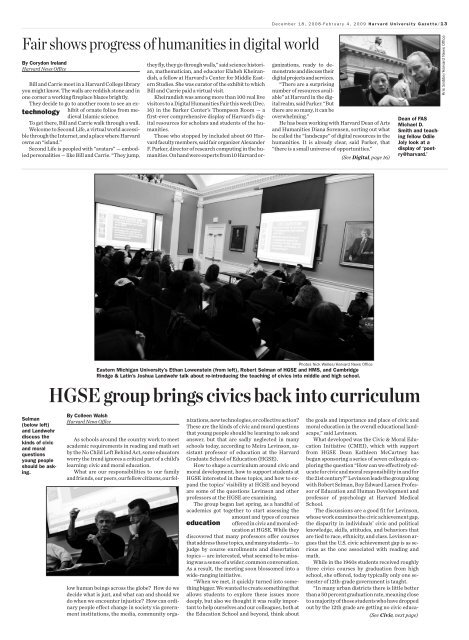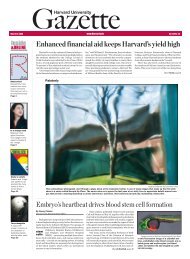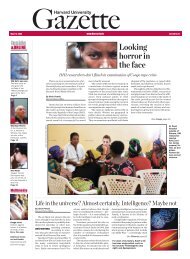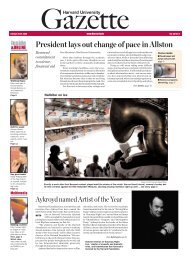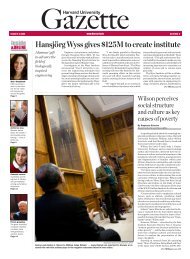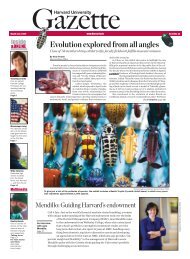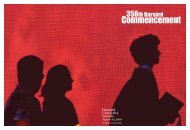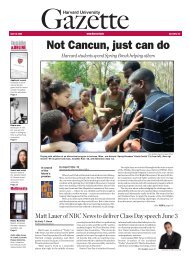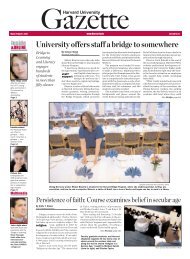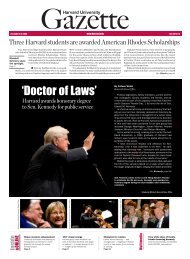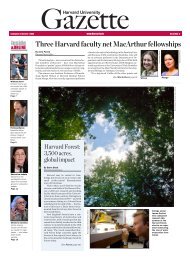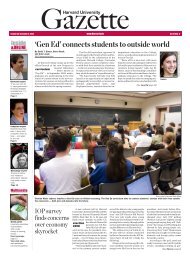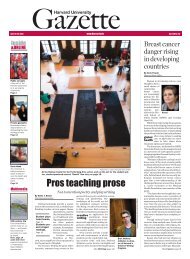12/ <strong>Harvard</strong> University Gazette December 18, 2008-February 4, 2009Findings add to knowledge about obesityand appetite regulation in the general populationNew obesity-related genes identifiedhealthA large international consortium hasmade significant inroads into uncoveringthe genetic basis of obesity, adding six newgenetic variants to the <strong>two</strong> already linkedto higher body mass index (BMI) in previousstudies. Most of the newly discoveredgenes had never before been suspectedof having a role in body weight and,curiously, many of the genes are active inthe central nervous system, suggestingthey may exert their effects via the brain.The study, from the Genetic Investigationof Anthropometric Traits (GIANT) consortium,appeared online in Nature Geneticson Dec. 14.“One of the major insights to come outof this is a new window into the biology ofobesity,” says Joel Hirschhorn of Children’sHospital Boston andthe Broad Institute of <strong>Harvard</strong>and MIT, who led the study togetherwith researchers from the University ofMichigan and research institutes in Oxfordand Cambridge, U.K. “One of the interestingthings is that the genes nearthese variants are all active in the centralnervous system, suggesting that inheritedvariation in appetite regulation may havesomething to do with people’s predispositionto obesity.The study used genetic informationfrom more than 32,000 people of Europeanancestry, drawn from 15genomewide association studies of BMIinvolving a total of 76 international researchinstitutes. A large-scale statisticalanalysis comparing BMI data with about2.4 million genetic variations, followed byvalidation of the most promising resultsin an additional 59,000 individuals, identifiedsix new genetic variants associatedwith higher BMI. It also strongly confirmeda role for <strong>two</strong> genetic variantsidentified last year “near the FTO andMC4R genes” says Hirschhorn.The effect of each individual variantwas modest, ranging from 0.06 to 0.33BMI units, and the paper estimates thatthe 1 percent of people with the most obesity-causingvariants will be on average 10pounds heavier than the 1 percent of peoplewith the fewest variants and 4 poundsheavier than the typical person.Hirschhorn also points out that theGIANT consortium team is likely to haveuncovered just a fraction of probably hundredsof genetic regions that each makesmall contributions to obesity — and thatidentifying new regions will require bothlarger studies and additional approaches.The team also compared their resultswith those from another large genomewideassociation study of BMI, led by deCODEGenetics in Iceland. Where comparisonswere possible, all of the variants identifiedby Hirschhorn and colleagues were stronglyconfirmed by data obtained by the de-CODE group. (The deCODE results are describedin an accompanying study publishedin the same issue of Nature Genetics.)According to Elizabeth Speliotes ofMassachusetts General Hospital, jointfirst author on the paper, it can be a majorchallenge to find genetic associations withstrong enough statistical evidence to becertain of their validity. However, shesays, “Thanks in part to the large group effortthe regions we report are clearly andreproducibly associated with body massindex.”The GIANT consortium is now performinglarge-scale studies to identifymore genetic variants contributing to therisk of obesity in both adults and children.“The next round of studies will involvenew collaborators and DNA from morethan 100,000 people,” says Hirschhorn.“We also hope to do analyses to determinewhether genetic variants have the sameeffects in different ethnic populations, inboth genders, and in individuals with extremeobesity compared to overweight ornormal-weight individuals.”Family or twin studies have shown thatgenetic factors account for 40 to 70 percentof population variation in BMI. But whileprevious studies have identified “obesitygenes” such as the LEP gene, which is mutatedin people with leptin deficiency andcauses severe obesity, little is known aboutthe genetics underlying more commonforms of weight dysregulation.According to the World Health Organization(WHO), there are more than 1billion overweight adults worldwide, andat least 300 million of them are obese (asdefined by a BMI of 30 or above). But thereare still no good treatments, and the needto uncover the biology underlying weightcontrol is becoming increasinglyurgent.“At present, we’ve only identifiedregions that show natural geneticvariations that influence bodymass index,” says Speliotes, who isalso a fellow at the Broad Instituteand an instructor in medicine at<strong>Harvard</strong> Medical School. “As welearn more about what some of thegenes in these regions do, we hopethat these discoveries might suggestroutes to new therapies forobesity.”Campaign(Continued from previous page)nothing and so he just “went to sleep.” At 2a.m. he woke up and found the completedspeech on his BlackBerry. He read it and respondedto his boss, “This is why you shouldbe president.”For the McCain campaign, the questionwas whether to make an issue of the Wrightcontroversy, and his aides gave their candidatefull credit for doing the right thing for theright reasons: “It was John McCain’s decision,”McInturff said. The pollster also gaveDavis credit to standing up, as the campaignwore on, to Republican Party pressure to reversecourse and exploit Obama’s connectionto the fiery preacher.To view archive video of the event,www.hks.harvard.edu/news-eventsAs McInturff told it, McCain’s decision notto touch the Wright stuff was initially one ofinstinctively doing the right thing. But as thecampaign continued, it was clear that it wasthe right decision tactically, too. Going afterWright wouldn’t have helped with the groups— young people and Hispanics — who wereslipping away from the Republicans. To havepressed ahead and won the White House with273 Electoral College votes while losing thePain(Continued from previous page)ever is hurting us,” he says. “If it’s an accidentalharm, chances are it’s a one-timething, and there’s no need to do anythingabout it. If it’s an intentional harm, however,it may be the first of many, so it’s goodto take notice and do something about it.It makes sense that our bodies and brainsmight amplify our experience of painwhen we know that the pain could signalthreats to our survival.”Kris Snibbe/<strong>Harvard</strong> News OfficeKurt Gray(left) andDaniel Wegnerdesignedan experimentthatshows thatpeople feelmore intensepain if theythink electricalshocksare inflictedpurposely.These findings speak to how people experiencepain and negative life events. Ifnegative events are seen as intended, theymay hurt more. This helps to explain whytorture is so excruciating — not only aretorture techniques themselves exceptionallypainful, but it’s the thought thatcounts — and makes torture hurt morethan mere pain.On the other hand, if negative eventsare seen as unintended, they may hurtless. This may explain, in part, why peoplein abusive relationships sometimescontinue to stay in them. By rationalizingthat an abusive partner did not intendharm, some victims may reduce their experienceof pain, which could make themless likely to leave the relationship and escapethe abuse.The research was supported by the NationalInstitute of Mental Health, theCanadian Social Sciences and HumanitiesResearch Council, and the Institute forHumane Studies.Justin Ide/<strong>Harvard</strong> News OfficePollster Bill McInturff (from right) regalesRick Davis, David Plouffe, David Axelrod,and Gwen Ifill with tales of the ‘trail.’popular vote would have “delegitimized thepresidency,” McInturff said.The scandal surrounding Illinois Gov. RodBlagojevich’s alleged attempt to auctionObama’s Senate seat to the highest biddercame up at a couple of points. Axelrod wasasked when he had last spoken with Blagojevich:“Thankfully, a long time ago.”Later a questioner from the floor tried toelicit some information on why longtimeObama adviser Valerie Jarrett, who was at onepoint seen as a candidate for the Obama senateseat, at another point suddenly wasn’t.Comparing Obama to Nelson Mandela interms of steadiness and intuitiveness, thequestioner asked whether some “intuition”on Obama’s part led him to name Jarrett to arole as a White House adviser instead.Axelrod’s response was that Jarrett is alongtime friend and adviser. “His preferencewas always that she serve in the WhiteHouse.”Ifill’s question whether Alaska Gov. SarahPalin helped or hurt the GOP ticket elicitedthis response from Davis: “To be honest, wewere losing. … You’ve got to win first.” He acknowledgedthat Palin seemed a riskier pickon Oct. 1 than on Sept. 6, and conceded,“We’ve got to work on our bench.”McInturff, however, noted that Palin hassome of the strongest “very favorable” ratingsamong Republicans and is likely to be a forcewithin the party over the next four to eightyears.
Fair shows progress of humanities in digital worldBy Corydon Ireland<strong>Harvard</strong> News OfficetechnologyBill and Carrie meet in a <strong>Harvard</strong> College libraryyou might know. The walls are reddish stone and inone corner a working fireplace blazes brightly.They decide to go to another room to see an exhibitof ornate folios from medievalIslamic science.To get there, Bill and Carrie walk through a wall.Welcome to Second Life, a virtual world accessiblethrough the Internet, and a place where <strong>Harvard</strong>owns an “island.”Second Life is peopled with “avatars” — embodiedpersonalities — like Bill and Carrie. “They jump,December 18, 2008-February 4, 2009 <strong>Harvard</strong> University Gazette/ 13they fly, they go through walls,” said science historian,mathematician, and educator Elaheh Kheirandish,a fellow at <strong>Harvard</strong>'s Center for Middle EasternStudies. She was curator of the exhibit to whichBill and Carrie paid a virtual visit.Kheirandish was among more than 100 real livevisitors to a Digital Humanities Fair this week (Dec.16) in the Barker Center’s Thompson Room — afirst-ever comprehensive display of <strong>Harvard</strong>’s digitalresources for scholars and students of the humanities.Those who stopped by included about 60 <strong>Harvard</strong>faculty members, said fair organizer AlexanderF. Parker, director of research computing in the humanities.On hand were experts from 10 <strong>Harvard</strong> organizations,ready to demonstrateand discuss theirdigital projects and services.“There are a surprisingnumber of resources available”at <strong>Harvard</strong> in the digitalrealm, said Parker. “Butthere are so many, it can beoverwhelming.”He has been working with <strong>Harvard</strong> Dean of Artsand Humanities Diana Sorensen, sorting out whathe called the “landscape” of digital resources in thehumanities. It is already clear, said Parker, that“there is a small universe of opportunities.”(See Digital, page 16)Dean of FASMichael D.Smith and teachingfellow OdileJoly look at adisplay of ‘poetry@harvard.’Kris Snibbe/<strong>Harvard</strong> News OfficeSelman(below left)and Landwehrdiscuss thekinds of civicand moralquestionsyoung peopleshould be asking.Photos Nick Welles/<strong>Harvard</strong> News OfficeEastern Michigan University’s Ethan Lowenstein (from left), Robert Selman of HGSE and HMS, and CambridgeRindge & Latin’s Joshua Landwehr talk about re-introducing the teaching of civics into middle and high school.HGSE group brings civics back into curriculumBy Colleen Walsh<strong>Harvard</strong> News OfficeAs schools around the country work to meetacademic requirements in reading and math setby the No Child Left Behind Act, some educatorsworry the trend ignores a critical part of a child’slearning: civic and moral education.What are our responsibilities to our familyand friends, our peers, our fellow citizens, our fellowhuman beings across the globe? How do wedecide what is just, and what can and should wedo when we encounter injustice? How can ordinarypeople effect change in society via governmentinstitutions, the media, community organizations,new technologies, or collective action?These are the kinds of civic and moral questionsthat young people should be learning to ask andanswer, but that are sadly neglected in manyschools today, according to Meira Levinson, assistantprofessor of education at the <strong>Harvard</strong>Graduate School of Education (HGSE).How to shape a curriculum around civic andmoral development, how to support students atHGSE interested in these topics, and how to expandthe topics’ visibility at HGSE and beyondare some of the questions Levinson and otherprofessors at the HGSE are examining.The group began last spring, as a handful ofacademics got together to start assessing theeducationamount and types of coursesoffered in civic and moral educationat HGSE. While theydiscovered that many professors offer coursesthat address these topics, and many students — tojudge by course enrollments and dissertationtopics — are interested, what seemed to be missingwas a sense of a wider, common conversation.As a result, the meeting soon blossomed into awide-ranging initiative.“When we met, it quickly turned into somethingbigger. We wanted to create something thatallows students to explore these issues moredeeply, but also we thought it was really importantto help ourselves and our colleagues, both atthe Education School and beyond, think aboutthe goals and importance and place of civic andmoral education in the overall educational landscape,”said Levinson.What developed was the Civic & Moral EducationInitiative (CMEI), which with supportfrom HGSE Dean Kathleen McCartney hasbegun sponsoring a series of seven colloquia exploringthe question “How can we effectively educatefor civic and moral responsibility in and forthe 21st century?” Levinson leads the group alongwith Robert Selman, Roy Edward Larsen Professorof Education and Human Development andprofessor of psychology at <strong>Harvard</strong> MedicalSchool.The discussions are a good fit for Levinson,whose work examines the civic achievement gap,the disparity in individuals’ civic and politicalknowledge, skills, attitudes, and behaviors thatare tied to race, ethnicity, and class. Levinson arguesthat the U.S. civic achievement gap is as seriousas the one associated with reading andmath.While in the 1960s students received roughlythree civics courses by graduation from highschool, she offered, today typically only one semesterof 12th-grade government is taught.“In many urban districts there is little betterthan a 50 percent graduation rate, meaning closeto a majority of those students who have droppedout by the 12th grade are getting no civic educa-(See Civic, next page)
- Page 1 and 2: 36/ Harvard University Gazette Dece
- Page 3 and 4: December 18, 2008-February 4, 2009
- Page 5 and 6: December 18, 2008-February 4, 2009
- Page 7 and 8: December 18, 2008-February 4, 2009
- Page 9 and 10: By Holly MetterFAS CommunicationsTh
- Page 11: December 18, 2008-February 4, 2009
- Page 15 and 16: By Emily T. SimonFAS Communications
- Page 17: 60HarvardcelebratesThe UniversalDec
- Page 20 and 21: December 18, 2008-February 4, 2009
- Page 22 and 23: Upon the recommendation of the dean
- Page 24 and 25: December 18, 2008-February 4, 2009
- Page 26 and 27: December 18, 2008-February 4, 2009
- Page 28 and 29: December 18, 2008-February 4, 2009
- Page 30 and 31: December 18, 2008-February 4, 2009
- Page 32 and 33: December 18, 2008-February 4, 2009
- Page 34: Antarctica(Continued from page 1)Su


